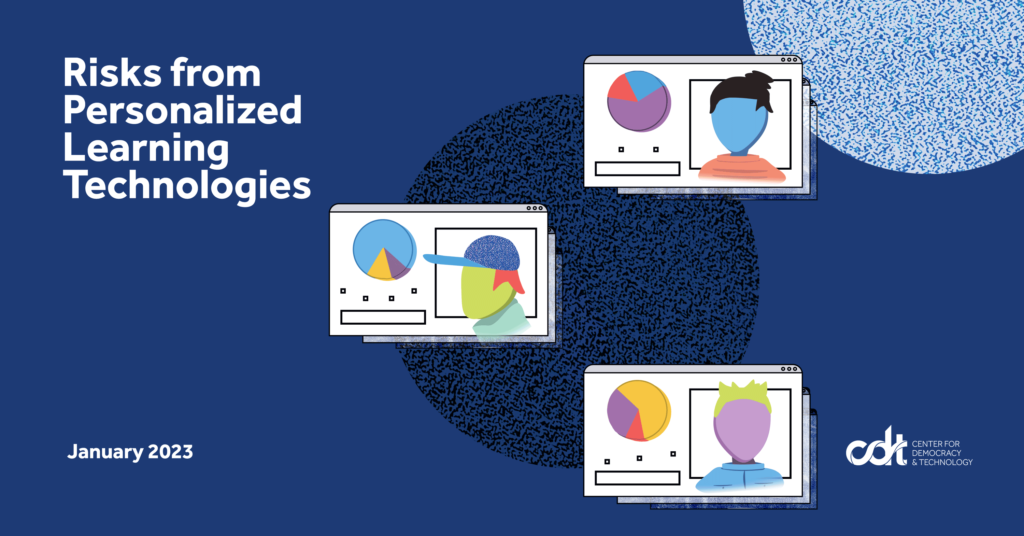Equity in Civic Technology, Privacy & Data
Report – Risks from Personalized Learning Technologies

Introduction
Personalized learning is a popular trend in K12 education. There are 17 states with incorporated personalized learning in their plans for the 2015 Every Student Succeeds Act, a federal law that lets school districts spend up to 3% of federal funding on personalized learning. Yet, “personalized learning” as a pedagogical practice has come to have many different meanings, and there are ongoing questions about how technology should be incorporated into personalized learning classrooms.
The multiple meanings of “personalized learning” can pose a challenge to teachers, technology administrators, and education policymakers. This guidance will make sense of the different meanings of “personalized learning,” provide an overview of different technologies that could be used in a personalized learning classroom, and recommend practices that enable responsible and privacy-forward uses of data and technology for personalized learning.
What is personalized learning?
The U.S. Department of Education defines personalized learning as “instruction in which the pace of learning and the instructional approach are optimized for the needs of each learner.” In practice, personalized learning has come to take on a wide variety of meanings, since any educational practice that caters to “the needs of each learner” could be considered personalized. The lack of clarity around personalized learning makes procuring technology for it more difficult, since educators must carefully consider the specific meaning of the phrase used by each vendor or practitioner.
However, some common practices have been popularized by the “personalized learning” trend. This guidance will expand upon the use of technology for each of these practices:
- Self-paced learning: Classrooms eschew having the entire class of students work on the same material simultaneously. Instead, teachers divide students into smaller groups or even individually, each of whom works on different activities, which may be facilitated by technology like digital educational materials. This allows classrooms to meet the differing needs of different students.
- Tailored goals: Students adopt different learning goals depending on their needs. This practice allows students to advance at their own pace and achieve mastery on a given subject before moving onto the next. Student goals might also draw from academic standards, college and workforce readiness, or soft skills. Technology helps facilitate personalized goals through software, called learner profiling & management systems, that collect, aggregate, and display data.
- Project-based learning: Students work individually or in small groups to create deliverables in response to an open-ended question. As with differentiated activities, sometimes students and teachers will work together to define individualized project criteria, including project- and student-specific assessments. Learning management systems can help manage the complexity of project-based learning by giving teachers a way of tracking multiple projects and assessments across multiple students and learning goals.
- Digital content: Classrooms use educational content that connects more readily with the individual student. Digital educational materials might help with this by allowing students to customize their on-screen avatar, which is then used as an insert for the student in educational content.
- Teacher-focused personalization: Teachers customize and improve their instructional capabilities. Broadly conceived, the above mentioned are about personalizing education for students. In contrast, teacher-focused personalization tools cater towards differing needs between teachers. These tools help make it easier for teachers to manipulate classroom environments according to their preference (e.g., classroom voice assistants).
How might technology be used for personalized learning, and what are the potential risks?
Technology is not wholly necessary to implement personalized learning, but it can be helpful. The latter half of this report discusses the ways technology might aid in personalized learning.
These tools for personalized learning raise three categories of privacy and ethical risks that educational policymakers should be aware of:
- Unproven benefits: There’s still a lack of scholarly consensus about the benefits of personalized learning and best practices, including any technology deployed for personalized learning. The reality may not live up to the stated capabilities of personalized learning technology.
- Bias: Some of the technologies in use to personalize learning for students may fail to work well for, and even discriminate against, some groups of students. Because the field is new, there has not yet been the time to research, recognize, and remedy any such bias.
- Privacy: Any third-party software that records and keeps data about students, such as demographics and academic performance, poses potential privacy risks, and technology for personalized learning is no different. The data collected by classroom technologies could be used for secondary purposes like targeted advertising or be left vulnerable to attacks from bad actors.


